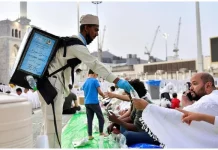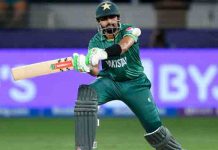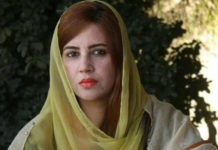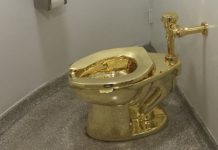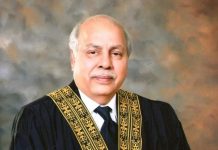- Nawaz eyes fourth stint as prime minister after contesting in polls.
- Tarar calls upon judges who convicted Nawaz to apologise to nation.
- Court turns down NAB’s plea to remand reference back to trial case.
The Islamabad High Court (IHC) Tuesday overturned the conviction of Pakistan Muslim League-Nawaz (PML-N) supremo Nawaz Sharif in the Al-Azizia reference, in a major boost for the senior politician’s bid to become the next prime minister of the country.
The veteran politician who arrived back home from four years of self-imposed exile in London in October, is eyeing to become the prime minister for a fourth time, according to his party.
To qualify to stand in elections scheduled for February 8, 2024, he needs a lifelong ban on holding any public office to be removed.
Sharif was convicted in 2018 on corruption charges in the case for failure to justify the source of the funds provided to set up Al-Azizia Steel Mills and Hill Metal Establishment (HME) in Saudi Arabia.
The high court announced the verdict it reserved after the completion of arguments from both defence and prosecution lawyers.
“It is unfortunate that if a former prime minister is facing such sham cases, then [we can’t imagine] what is happening to a common man,” senior lawyer Irfan Qadir told Geo News, calling upon the judges who convicted Nawaz to apologise to the nation.
He mentioned that it was the Supreme Court that had instructed the National Accountability Bureau (NAB) to file references against Nawaz in light of the controversial Panama verdict.
It is worth mentioning that despite the case being pending since 2017, the NAB prosecutor failed to provide any evidence against the PML-N supremo for having assets beyond means, noting that the reference was filed based on directions from the JIT — formed on the SC’s direction.
An accountability court on December 24, 2018, sentenced the former prime minister to seven years in jail and imposed a fine of 2.5 million pounds in the Al-Azizia Steel Mills reference.
Nawaz had submitted an appeal against the decision of the accountability court, requesting the court to annul the imprisonment and fine awarded along with the conviction.
It may be noted that Nawaz has also been acquitted in the Avenfield Apartments reference, after the high court last month accepted his appeal on the conviction in the case.
The hearing
A two-member divisional bench — comprising IHC Chief Justice Aamer Farooq and Justice Miangul Hassan Aurangzeb — heard Nawaz’s appeal against his conviction in the Al-Azizia reference and NAB’s plea seeking an extension of imprisonment awarded to the politician in the case, clubbing both the petitions together.
Nawaz, accompanied by his lawyers appeared before the court.
During the hearing, when asked whether NAB had proved that the former prime minister’s children were dependent on him, Wajid Zia, the prosecution’s primary witness, acknowledged that there was no evidence in this regard.
The court inquired on what basis was the burden of proof shifted on Nawaz.
At this, the former prime minister’s legal counsel Advocate Amjad Pervez apprised the bench that the trial court relied on the three miscellaneous applications along with Nawaz’s speech in the National Assembly and his son Hussain Nawaz’s TV interview.
The lawyer contended that the evidence from one case cannot be used in another, especially when both cases vary in nature.
He further underscored that it was the prosecution’s responsibility to assess the value of [Nawaz’s] income and assets and that the former prime minister was “dependent” on his sons.
“It was to be proved by the prosecution that benami assets were established [by Nawaz].”
“If [the prosecution] has not provided any evidence [in this regard], then the said case doesn’t fall in the category of ‘assets beyond means’,” the lawyer noted adding, “There is no such case where the accused was sentenced on accounts of lack of clear and logical proof regarding the ownership [of the assets].”
Responding to Pervez’s arguments, the NAB prosecutor apprised the court that the references were filed in the accountability court on the directions of the Supreme Court of Pakistan (SC) which also constituted a joint investigation team (JIT) to probe the references.
The NAB official further maintained that the anti-graft body investigated the issue of benami assets following the SC decision.
He informed the court that charges against Nawaz were framed under the allegations of corrupt practices. He said that the decision of the accountability court of Al-Azizia reference is “biased”.
Justice Hassan remarked that NAB can give the arguments on merit and have the conviction upheld.
Meanwhile, Justice Farooq directed the NAB prosecutor to state the facts and then link them with the case in his arguments based on merit
The court, however, turned down NAB’s request to remand the case back to the trial court once again and approved Nawaz’s appeal against the conviction.
Al-Azizia reference
Hussain, who is the elder son of the former prime minister, claimed that he had received a sum of $5.4 million from his grandfather to establish the steel conglomerate in Saudi Arabia. The payment was made by a Qatari royal on the request of Nawaz. Thereafter, scrap machinery was transported from their Ahli Steel Mills in Dubai to Jeddah to establish Al-Azizia in 2001.
Meanwhile, the JIT constituted to investigate the graft allegations insisted that the real owner of the mills was Nawaz, and it was being operated by his son on his behalf. At that time, Hussain was 29-years-old. The JIT also held that Nawaz received 97% profit as ‘gifts’ from Hill Metals Establishment, another company established by Hussain in 2005, in Saudi Arabia.
Nawaz transferred 77% of the said amount to his daughter, Maryam Nawaz Sharif. Here as well, the NAB claimed that since Nawaz received a large profit from Hussain’s companies, he is the real owner and not his son.
However, during the proceedings, the NAB could not substantiate its claim through documentary evidence and instead placed the burden of proof on the accused.







